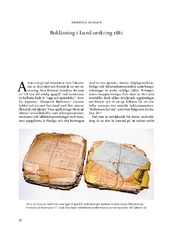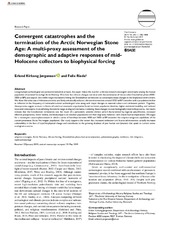Blar i tittel Artikler, rapporter og annet (arkeologi, historie, religionsvitenskap og teologi)
Viser treff 21-40 av 272
-
Bokläsning i Lund omkring 1880
(Journal article; Tidsskriftartikkel, 2014)Vilka bokläsarna var under slutet av 1800-talet är höljt i dunkel. Denna undersökning utgår från ett unikt källmaterial från ett kommersiellt lånebibliotek i 1880-talets Lund, som kan visa på vilka böcker som lånades ut och vilka låntagarna var. -
Bokmelding. Knut Dørum og Eirin Holberg: Frå høvdingdøme til statsmakt i Noreg ca. 200–1350
(Journal article; Tidsskriftartikkel; Peer reviewed, 2018-11-21) -
Bonde og borgerkrig - Lokalkonflikter og de norske innbyrdesstridene
(Journal article; Tidsskriftartikkel; Peer reviewed, 2019)Historians have traditionally treated peasant unrest in late twelfth- and early thirteenth-century Norway as part of a wider challenge to royal authority, as kings struggled to suppress political adversaries and rival claimants to the throne. This article seeks to shed greater light on this assumed correlation by analysing changing patterns of peasant mobilization. To do so, it proposes a terminological ... -
Born Dead or Alive? Revisiting the Definition of Stillbirths in Norway
(Journal article; Tidsskriftartikkel; Peer reviewed, 2021-03-31)Since 1947 there has been a common understanding among Norwegian historians and demographers that stillbirths registered in the country prior to 1839 included infants who were born alive but died within 24 hours. This paper shows that a revision of this definition is necessary. During the first half of the 19th century, several memoranda, revisions and circulars were distributed by the Danish-Norwegian ... -
Brodtkorbneset and Steintjørna: Two Hearth-Row Sites in Pasvik, Arctic Norway
(Chapter; Bokkapittel, 2019)During the Viking Age and the early medieval period, hearth row sites became a distinct feature of Sámi settlements over the vast interior region of northern Fennoscandia. Consisting of large, rectangular hearths organized in a linear pattern, these sites represent a new way of organizing domestic space and also reflect new environmental preferences. In this paper, the author gives an overview ... -
Buried in between: Re-interpreting the Skjoldehamn Medieval Bog Burial of Arctic Norway
(Journal article; Tidsskriftartikkel; Peer reviewed, 2021-12-17)THE 11TH-CENTURY SKJOLDEHAMN GRAVE is a remarkable accidental find, discovered in a bog in coastal Arctic Norway in 1936. The grave consisted of a fully clothed skeleton wrapped in a wool blanket, lashed with leather straps and tin ring-ornamented woven bands. The body was laid on a reindeer pelt, which in turn was placed on sticks of birch. Finally, the body was covered with birch bark, and potentially ... -
Buying and Borrowing Books: Book Consumption In Late Nineteenth-Century Sweden
(Journal article; Tidsskriftartikkel; Peer reviewed, 2017-07-09)Who read what in the late nineteenth century Swedish society? What books were available in the bookshops and the libraries, and what books were the most popular? This study aims to offer preliminary answers to questions like these, based on sales’ and borrowers’ ledgers from three of the most common types of literary institutions of the time; a parish library, a bookshop, and a commercial lending ... -
Caring for the dead? An alternative perspective on Sámi reburial
(Journal article; Tidsskriftartikkel; Peer reviewed, 2019-04-29)This article is an effort to critically discuss Sámi repatriation and reburial practice based on the analysis of five repatriation cases. Since the seminal repatriation (and burial) of the skulls of Somby and Hætta in Gávvuonna/Kåfjord in 1997, and the more recent reburial of 94 skeletons in Njauddâm/Neiden in 2011, a precedent seems established in Norway that allows the unconditional reburial of ... -
Climatic changes cause synchronous population dynamics and adaptive strategies among coastal hunter-gatherers in Holocene northern Europe
(Journal article; Tidsskriftartikkel; Peer reviewed, 2020-03-16)Synchronized demographic and behavioral patterns among distinct populations is a well-known, natural phenomenon. Intriguingly, similar patterns of synchrony occur among prehistoric human populations. However, the drivers of synchronous human ecodynamics are not well understood. Addressing this issue, we review the role of environmental variability in causing human demographic and adaptive responses. ... -
Cold Wars and Summer-Night Dances: An Archaeology of the Iron Curtain: Material and Metaphor, by Anna McWilliams and Minnen från vår samtid: Arkeologi, materialitet och samtidshistoria (Memories of our Time: Archaeology, Materiality and Contemporary History) by Maria Persson
(Journal article; Tidsskriftartikkel; Peer reviewed, 2016-06) -
Constructive forgetting and reconciliatory memory in nineteenth-century historical fiction A comparative perspective on Scandinavianism, pan-Germanism and Greater Netherlandism
(Chapter; Bokkapittel, 2023-06-30)This chapter studies how far the reconciliation of a troublesome shared past through historical fiction can be considered a general characteristic of pan-national movements in nineteenth-century Europe. A cross-case analysis shows that this praxis was most widespread and most intricately developed in Scandinavianism, while it to a lesser degree also left its mark on pan-Germanism as expressed through ... -
Contrasting patterns of prehistoric human diet and subsistence in northernmost Europe
(Journal article; Tidsskriftartikkel; Peer reviewed, 2018-01-18)Current archaeological evidence indicates the transition from hunting-fishing-gathering to agriculture in Northern Europe was a gradual process. This transition was especially complex in the prehistoric North Fennoscandian landscape where the high latitude posed a challenge to both domestic animal breeding and cereal cultivation. The conditions varied, the coastal dwellers had access to rich marine ... -
Convergent catastrophes and the termination of the Arctic Norwegian Stone Age: A multi-proxy assessment of the demographic and adaptive responses of mid-Holocene collectors to biophysical forcing
(Journal article; Tidsskriftartikkel; Peer reviewed, 2019-07-31)Using multiple archeological and paleoenvironmental proxies, this paper makes the case for a climate-induced convergent catastrophe among the human population of terminal Stone Age Arctic Norway. We show that climatic changes correlate with the termination of the so-called Gressbakken phase (4200–3500 cal BP), and unpack the middle-range mechanisms linking the Gressbakken termination to contemporaneous ... -
Creencias, Rituales y Memoria. Una introducción a la Ciencia Cognitiva de la Religión
(Journal article; Tidsskriftartikkel; Peer reviewed, 2019)La Ciencia Cognitiva de la Religión es un campo de investigación interdisciplinario que surge en los años 1990s, congregando distintas disciplinas y métodos. Su interés es explicar los procesos cognitivos que subyacen a las creencias y prácticas religiosas, así como situar las mismas en la historia natural y evolutiva de nuestra especie. En el presente artículo se describirá dicho campo interdisciplinario ... -
Dangerous Food. Climate change induced elevated heavy metal levels in Younger Stone Age seafood in northern Norway.
(Journal article; Tidsskriftartikkel; Peer reviewed, 2020-01-28)Stable isotope and elemental analyses of the Atlantic cod (<i>Gadus morhua</i>) and harp seal (<i>Phoca groenlandica</i>) bone component of the marine food that dominated the Younger Stone Age (c. 6.1–3.5 ka BP) diet in Varanger, Arctic northern Norway, indicate, at times, climate change induced highly elevated levels of the heavy metals cadmium (Cd) and lead (Pb), and elevated levels of mercury ... -
The de-dramatization of history and the prose of bourgeois life
(Journal article; Tidsskriftartikkel; Peer reviewed, 2015-02-20)Emperor and Galilean has received renewed interest the last decade. It has been revalued and upgraded, it has been attributed a major role in the development of Ibsen’s authorship, and it has been interpreted as an expression of the new uncertainties of modernity. The play definitely deviates from Ibsen’s earlier historical dramas; it does not hold up an exemplary past or try to emulate a ... -
Den nordlige jernalder. Kulturminner og funn fra Malangen til Loppa
(Book; Bok, 2014-11) -
Depictions of Laestadianism 1850-1950
(Journal article; Tidsskriftartikkel; Peer reviewed, 2020-05-23)The issue to be discussed here is how society’s views of the Laestadian revival has changed over the course of the revival movement’s first 100 years. The article claims that society’s emerging view of the revival is characterized by two different positions. The first period is typical of the last part of the nineteenth century and is characterized by the fact that the evaluation of the revival took ... -
Despina Stratigakos Hitler’s Northern Utopia. Building the new order in occupied Norway Norsk utgave: Hitlers norske drøm. Nazismens ariske utstillingsvindu Princeton University Press, Princeton og Oxford 2020, 352 s. Vega forlag, Oslo 2021, 327 s
(Journal article; Tidsskriftartikkel; Peer reviewed, 2022-10-14)I minnelandskapene etter den tyske okkupasjonen av Norge stiller først og fremst sporene i betong og jern seg til skue for oss. Festningsverkene og jernbanene har særlig hatt evnen til å fange forfatteres interesse når studiet av okkupasjonsmaktens byggeprogram står på dagsordenen. I sin siste bok, som nå også foreligger i norsk oversettelse, bemerker den kanadiske arkitekturhistorikeren Despina ... -
The destinies of German-Born people in Russia at the turn of the millennium
(Journal article; Tidsskriftartikkel; Peer reviewed, 2021-09-29)This article studies the stories of Russian citizens who were born in Germany but reside in Russia. Most of them had relocated to Russia as a result of the withdrawal of Russian troops from Germany after 1990. Analysing individual data from the 2002 and 2010 censuses, the author traces the lives of children born into the families of Soviet military men based in East Germany after World War II. Over ...


 English
English norsk
norsk


















